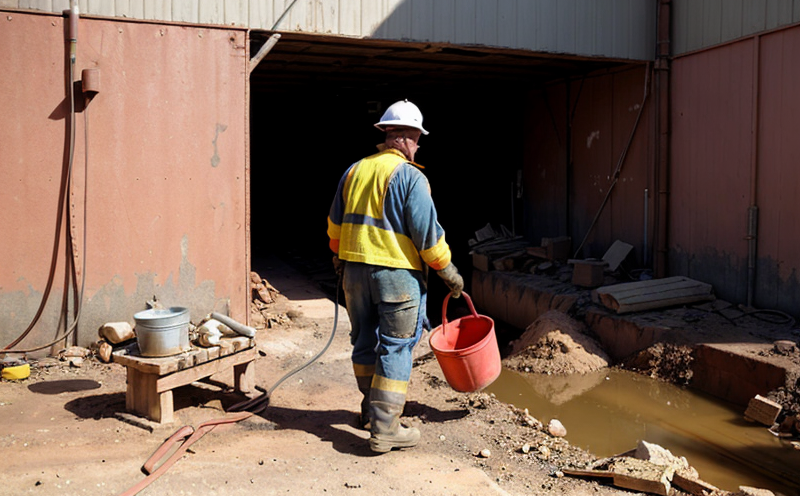ASTM F1930 Flame Resistance of Protective Clothing Testing
The ASTM F1930 standard outlines a method for evaluating the flame resistance of protective clothing. This is particularly important in industries where workers are exposed to fire hazards, such as mining safety and occupational health. Flame-resistant clothing serves as a critical layer of protection against flash fires, thermal burns, and other potential injuries.
The test involves subjecting the fabric samples to a controlled flame for 3 seconds. The goal is to measure the duration that the fabric continues to smolder or burn after the flame source is removed. This test helps ensure that protective clothing meets specific performance criteria necessary for worker safety in high-risk environments, such as mining.
Key parameters include the type of fabrics and the construction methods used. Synthetic fibers like Nomex are often preferred due to their inherent flame resistance properties. However, natural fibers can be treated with flame-retardant chemicals to achieve compliance with ASTM F1930 standards.
The test apparatus typically consists of a specially designed flammability tester capable of delivering consistent and reproducible results. The testing process is standardized to ensure that all samples are subjected to identical conditions, which helps in maintaining the integrity of comparative data.
Acceptance criteria for ASTM F1930 include limits on after-flame time (the duration a sample continues to burn), after-smoldering time (the period during which embers continue to smolder), and total heat energy released. Compliance with these parameters ensures that the protective clothing can effectively protect workers from fire-related hazards.
For R&D engineers, this test is crucial in developing new materials for flame-resistant garments. By understanding the performance characteristics of different fabrics under ASTM F1930 conditions, they can optimize designs to enhance safety and comfort. Quality managers and compliance officers rely on these tests to ensure that their suppliers meet strict industry standards. Additionally, procurement teams use these results to select vendors who deliver high-quality protective clothing.
In the context of mining safety, flame-resistant clothing is essential for protecting workers from unexpected fires in underground mines or other hazardous areas. Properly tested and certified protective clothing can significantly reduce the risk of injury or death caused by fire incidents.
Eurolab Advantages
At Eurolab, we offer unparalleled expertise in ASTM F1930 testing for flame-resistant protective clothing. Our team of certified professionals ensures that every test adheres to the latest standards and guidelines.
- Accurate Testing: Our state-of-the-art facilities provide precise control over environmental conditions, ensuring consistent results across all tests.
- Comprehensive Analysis: We go beyond basic flame resistance testing by also evaluating other critical safety features of protective clothing.
- Expert Guidance: Our consultants can help you interpret test data and make informed decisions about material selection and design improvements.
- Detailed Reporting: Comprehensive reports are provided, including recommendations for enhancing the performance of your products.
We pride ourselves on delivering reliable, accurate results that meet or exceed industry expectations. Our commitment to quality ensures that you receive the best possible service in ASTM F1930 flame resistance testing.
Customer Impact and Satisfaction
Our clients benefit immensely from Eurolab’s ASTM F1930 flame resistance testing services. By ensuring that their protective clothing meets the highest safety standards, we help them protect their workers effectively against fire hazards.
- Enhanced Worker Safety: Compliance with ASTM F1930 helps prevent workplace injuries and fatalities due to fires.
- Regulatory Compliance: Our services assist clients in meeting regulatory requirements, thereby avoiding costly fines and legal issues.
- Satisfied Customers: High levels of customer satisfaction are achieved by providing accurate, reliable test results and personalized support throughout the testing process.
We are committed to maintaining our reputation for excellence. Our satisfied customers include quality managers, compliance officers, R&D engineers, and procurement teams who rely on us for their testing needs.
Use Cases and Application Examples
- Mining Industry: Ensuring that workers in underground mines are protected against unexpected fires with flame-resistant clothing.
- Hazardous Environments: Protecting personnel exposed to industrial fires or explosions in manufacturing facilities, refineries, and similar settings.
- Petrochemical Sector: Providing firefighters with garments that can withstand intense heat during rescue operations involving hazardous materials.
- Firefighting Teams: Equipping firefighters with protective clothing that meets stringent flame resistance standards to ensure their safety.
In these high-risk environments, the ASTM F1930 test plays a crucial role in ensuring that workers have reliable protection against fire hazards. By incorporating this testing into your quality control and product development processes, you can enhance worker safety and comply with industry regulations.





